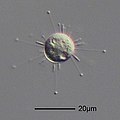Suctoria
Suctoria is a subclass of protozoa within the class Ciliophora. Suctorians are characterized by their unique feeding mechanism; unlike other ciliates that use cilia to gather food particles throughout their life, suctorians, after an initial ciliated larval stage, transform into sessile adults that lack cilia but possess specialized tentacles used for feeding. These tentacles attach to prey, typically other protozoans, and draw out the contents of the prey cell through a process known as phagocytosis.
Characteristics
Suctorians exhibit a fascinating life cycle that begins with a free-swimming, ciliated larval stage known as the swarmer. During this stage, the organism disperses to find a suitable substrate to attach to. Upon attachment, the suctorian undergoes a transformation where it loses its cilia and develops feeding tentacles. These tentacles are not only pivotal for feeding but also for anchoring the organism to the substrate.
The body of a suctorian is typically globular or irregular in shape, and the number and arrangement of tentacles can vary significantly among different species. The tentacles are equipped with specialized structures called haptocysts at their tips, which are used to pierce the prey's cell membrane and establish a feeding tube through which the prey's cytoplasm is ingested.
Reproduction
Suctorians reproduce asexually through a process known as budding. In this process, a new individual, or bud, forms from the body of the parent. This bud develops its own tentacles before detaching to lead an independent life. Some species of suctorians can also reproduce sexually, a less common mode of reproduction where gametes are produced and fuse to form a zygote, which then develops into a new individual.
Ecology
Suctorians are found in a variety of aquatic environments, including freshwater and marine habitats. They play a significant role in the microbial food web by preying on other protozoans and, in turn, being preyed upon by larger organisms. Their presence and abundance can be indicative of the health and stability of aquatic ecosystems.
Classification
The classification of suctorians within the broader group of ciliates has been subject to revision as new molecular and genetic data become available. They are currently placed in the subclass Suctoria within the class Ciliophora, but this classification may evolve with further research.
Research and Importance
Suctorians are of interest to researchers for several reasons. Their unique feeding mechanism and life cycle provide insights into protozoan evolution and ecology. Additionally, studying suctorians can help scientists understand the dynamics of aquatic ecosystems and the role of protozoans in microbial food webs.
See Also
Transform your life with W8MD's budget GLP-1 injections from $125.
W8MD offers a medical weight loss program to lose weight in Philadelphia. Our physician-supervised medical weight loss provides:
- Most insurances accepted or discounted self-pay rates. We will obtain insurance prior authorizations if needed.
- Generic GLP1 weight loss injections from $125 for the starting dose.
- Also offer prescription weight loss medications including Phentermine, Qsymia, Diethylpropion, Contrave etc.
NYC weight loss doctor appointments
Start your NYC weight loss journey today at our NYC medical weight loss and Philadelphia medical weight loss clinics.
- Call 718-946-5500 to lose weight in NYC or for medical weight loss in Philadelphia 215-676-2334.
- Tags:NYC medical weight loss, Philadelphia lose weight Zepbound NYC, Budget GLP1 weight loss injections, Wegovy Philadelphia, Wegovy NYC, Philadelphia medical weight loss, Brookly weight loss and Wegovy NYC
|
WikiMD's Wellness Encyclopedia |
| Let Food Be Thy Medicine Medicine Thy Food - Hippocrates |
Medical Disclaimer: WikiMD is not a substitute for professional medical advice. The information on WikiMD is provided as an information resource only, may be incorrect, outdated or misleading, and is not to be used or relied on for any diagnostic or treatment purposes. Please consult your health care provider before making any healthcare decisions or for guidance about a specific medical condition. WikiMD expressly disclaims responsibility, and shall have no liability, for any damages, loss, injury, or liability whatsoever suffered as a result of your reliance on the information contained in this site. By visiting this site you agree to the foregoing terms and conditions, which may from time to time be changed or supplemented by WikiMD. If you do not agree to the foregoing terms and conditions, you should not enter or use this site. See full disclaimer.
Credits:Most images are courtesy of Wikimedia commons, and templates, categories Wikipedia, licensed under CC BY SA or similar.
Contributors: Prab R. Tumpati, MD



